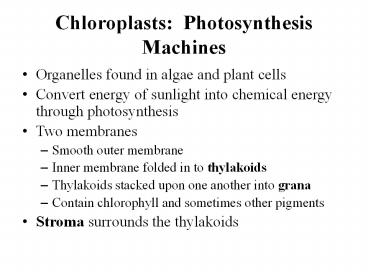Chloroplasts: Photosynthesis Machines PowerPoint PPT Presentation
1 / 17
Title: Chloroplasts: Photosynthesis Machines
1
Chloroplasts Photosynthesis Machines
- Organelles found in algae and plant cells
- Convert energy of sunlight into chemical energy
through photosynthesis - Two membranes
- Smooth outer membrane
- Inner membrane folded in to thylakoids
- Thylakoids stacked upon one another into grana
- Contain chlorophyll and sometimes other pigments
- Stroma surrounds the thylakoids
2
Figure 5.13
3
Ribosomes Protein Synthesizers
- Some scattered in the cytoplasm and cytoskeleton
- Others associated with RER
- Often found in chains of polyribosomes
(polysomes) - Composed of large and small subunits of
ribonucleoprotein - Larger 80S variety, composed of 60S and 40S
subunits
4
The Cytoskeleton A Support Network
- Flexible framework of molecules criss-crossing
the cytoplasm - Several functions
- Anchoring organelles
- Moving RNA and vesicles
- Permitting shape changes and movement in some
cells - Two types Microfilaments and microtubules
5
(No Transcript)
6
The Kingdom of the Fungi
- Myceteae
- Great variety and complexity
- Approximately 100,000 species
- Can be divided in to two groups
- Macroscopic fungi
- Microscopic fungi
- Yeasts
- Round oval shape
- Unique mode of asexual reproduction
- Hyphae
- Long, threadlike cells
- Some are dimorphic
- Majority are unicellular or colonial
- Some form a pseudohypha
7
Figure 5.15
8
Figure 5.16
9
Fungal Nutrition
- Heterotrophic
- Acquire nutrients from substrates
- Most fungi are saprobes
- Can also be parasites
- General method of obtaining nutrition
- Penetrates the substrate
- Secretes enzymes
- Breaks down the enzymes into small molecules
- Absorbs the molecules
- Can absorb a wide variety of substrates
- Large medical and agricultural importance
10
Figure 5.17
11
Organization of Microscopic Fungi
- Most grow in loose associations or colonies
- Yeasts- soft, uniform texture and appearance
- Filamentous fungal colonies- cottony, hairy, or
velvety textures - Mycelium- the woven, intertwining mass of hyphae
that makes up the body or colony of a mold - Unique organizational features of hyphae
- Septa- divide the hyphae in to segments (most
fungi- septate hyphae) - Nonseptate hyphae- one long, continuous cell
- Functions of hyphae
- Vegetative hyphae (mycelia)- visible mass of
growth on the substrate surface penetrates the
substrate to digest and absorb nutrients - Reproductive (fertile) hyphae- from vegetative
hyphae responsible for the production of spores
12
Figure 5.18
13
Reproductive Strategies and Spore Formation
- Most can propagate by growth of hyphae or
fragmentation - Primary reproductive mode- the production of
spores - Function of spores
- Multiplication
- Survival
- Producing genetic variation
- Dissemination
- Large diversity in spores among the fungi
- General grouping of spores- asexual and sexual
14
Fungal Identification and Cultivation
- Medical specimens
- Isolated on special types of media
- Observed macroscopically and microscopically
- Usually use sexual spore-forming structures and
spores - Other characteristics that contribute to
identification - Hyphal type
- Colony texture and pigmentation
- Physiological characteristics
- Genetic makeup
15
The Roles of Fungi in Nature and Industry
- Nearly all fungi are free-living and dont need a
host - Human infection by pathogenic fungi usually
occurs through accidental contact - Humans are generally resistant to fungal
infection, except for two main types - Primary pathogens
- Opportunistic pathogens
- Mycoses vary in the way the agent enters the body
and the degree of tissue involvement
16
(No Transcript)
17
- Not only involved in infections
- Allergies
- Poisoning
- Agricultural damage
- Benefits of fungi
- Decomposing organic matter and returning
essential minerals to the soil - Mycorrhizae increase the ability of plant roots
to absorb water and nutrients - Production of
- Antibiotics
- Alcohol
- Organic acids
- Vitamins
- Food flavorings

